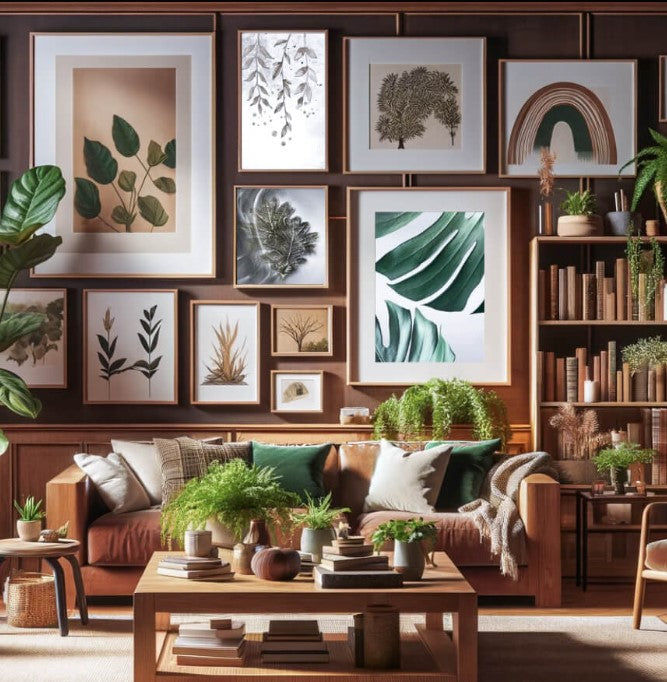Bringing the beauty of nature indoors is a timeless way to enhance your living space. Natural elements add warmth, texture, and a sense of tranquility to any home, creating a harmonious environment that feels both welcoming and serene. Whether you live in an urban apartment or a countryside retreat, incorporating nature into your decor can transform your space into a calming oasis. Here’s how you can seamlessly integrate natural elements into your home decor.
1. Bring in Greenery with Plants
One of the most straightforward and effective ways to incorporate nature into your home is by adding plants. Houseplants not only purify the air but also add a refreshing touch of greenery that can brighten any room. From large potted trees to small succulents, there’s a plant for every space and lifestyle.
Consider placing tall plants like fiddle leaf figs or snake plants in corners to fill empty spaces and create visual interest. Smaller plants like pothos or spider plants can be placed on shelves, windowsills, or coffee tables. Hanging plants, such as trailing ivy or Boston ferns, can add a dynamic element to your decor by drawing the eye upward and creating a layered effect.
For those who may not have a green thumb, low-maintenance plants like cacti, aloe vera, or ZZ plants are excellent choices. These hardy plants require minimal care and can thrive in a variety of indoor environments.
2. Incorporate Natural Materials
Using natural materials in your furniture and decor is a wonderful way to bring the outdoors in. Materials like wood, stone, bamboo, and rattan add texture and warmth to a space, making it feel cozy and grounded.
Wood is perhaps the most versatile of natural materials. Whether it’s a rustic wooden coffee table, sleek hardwood floors, or reclaimed wood shelves, wood adds character and a sense of authenticity to your home. Different types of wood, from oak to walnut, can create different moods, from modern and minimalist to warm and traditional.
Stone is another material that can make a big impact. Consider incorporating stone elements like a marble countertop, a slate fireplace, or a stone accent wall. Stone adds a sense of permanence and natural beauty to a space, and its cool tones can create a soothing atmosphere.
Bamboo and rattan are perfect for adding a touch of the tropics to your decor. These materials are not only sustainable but also incredibly versatile. Bamboo blinds, rattan chairs, or wicker baskets can add a light, airy feel to your home while maintaining a connection to nature.
3. Embrace Natural Light
Natural light is one of the most powerful elements in home decor. It can transform a room, making it feel larger, more open, and more inviting. To maximize the natural light in your home, start by choosing window treatments that allow light to flow freely.
Sheer curtains or light-filtering blinds are great options for letting in sunlight while still providing privacy. If you’re looking to enhance the natural light in a room, consider using mirrors strategically. Placing a mirror opposite a window can reflect light and make the space feel brighter and more expansive.
In spaces with limited natural light, consider adding light fixtures that mimic the warmth of natural sunlight. Warm LED bulbs, for example, can create a cozy, inviting ambiance that feels natural and comfortable.
4. Incorporate Natural Textiles
Textiles made from natural fibers add softness and warmth to your home while maintaining a connection to nature. Materials like cotton, linen, wool, and jute are durable, breathable, and add a tactile quality to your decor.
Cotton and linen are perfect for bedding, curtains, and upholstery. Their light, breathable qualities make them ideal for creating a relaxed, comfortable atmosphere. Opt for neutral tones or muted colors to enhance the natural feel.
Wool is a fantastic choice for rugs, throws, and pillows. Wool adds warmth and texture to a space, making it feel cozy and inviting. A wool area rug can anchor a room, while a chunky wool blanket draped over a sofa adds a touch of rustic charm.
Jute and sisal are great for adding texture underfoot. Jute rugs, for example, are durable and add an earthy element to any room. These natural fibers are also biodegradable, making them an eco-friendly choice for your home.
5. Add Water Features
Water has a calming effect that can bring a sense of peace and tranquility to your home. Incorporating water features, such as fountains or aquariums, can help create a relaxing environment that soothes the senses.
A small indoor fountain can be placed in a living room, bedroom, or entryway to add the gentle sound of flowing water. The sound of water can help drown out background noise and create a serene ambiance.
An aquarium, whether large or small, can also bring the calming presence of water into your home. Watching fish swim can be incredibly relaxing and adds a living element to your decor. Choose an aquarium with a design that complements your decor, whether it’s sleek and modern or more traditional.
6. Incorporate Natural Scents
Scents are a powerful way to bring nature into your home. Incorporating natural scents can enhance the atmosphere of your space and create a more immersive experience.
Consider using essential oil diffusers, candles, or incense made from natural ingredients. Scents like lavender, eucalyptus, pine, and citrus can evoke different aspects of nature and help set the mood in your home. For example, lavender is known for its calming properties, making it a great choice for bedrooms, while eucalyptus can invigorate and refresh a space like a bathroom or home office.
Fresh flowers and herbs are another way to add natural scents to your home. A vase of fresh roses, a bundle of dried lavender, or a small indoor herb garden can fill your home with delightful, natural aromas.
7. Use Earthy Colors
The color palette of your home plays a significant role in how connected it feels to nature. Earthy tones like greens, browns, and neutrals can create a soothing environment that mirrors the outdoors.
Consider painting your walls in shades of sage, olive, or taupe to create a calm, grounded atmosphere. Accent these colors with natural elements like wooden furniture, stone accessories, or plants to enhance the organic feel of the space.
If you prefer a bolder look, consider using deep, rich colors like forest green, terracotta, or charcoal. These colors can add depth and drama to a room while still maintaining a connection to nature.
8. Incorporate Natural Art and Decor
Art and decor inspired by nature can help tie your space together and reinforce the natural theme. Consider incorporating artwork that features landscapes, botanical prints, or animal motifs.
Decorative elements like driftwood sculptures, stone vases, or seashell collections can add texture and interest to your space. These natural decor pieces not only look beautiful but also add a tactile quality that makes your home feel more inviting.
For a more personal touch, consider displaying items you’ve collected from nature, such as a jar of sand from your favorite beach, a collection of stones, or pressed flowers. These items can serve as meaningful reminders of your connection to the natural world.
Conclusion
Incorporating natural elements into your home decor is more than just a design trend—it’s a way to create a space that feels calm, grounded, and connected to the earth. By bringing in greenery, using natural materials, embracing natural light, and adding personal touches inspired by nature, you can create a home that is not only beautiful but also nurturing to your well-being.
As you transform your space, remember that the key to incorporating nature into your decor is to focus on what resonates with you personally. Whether you’re drawn to the texture of natural fibers, the tranquility of water features, or the vibrant life of houseplants, there are countless ways to make nature a part of your home. By doing so, you’ll create a living space that not only reflects your style but also brings the calming and rejuvenating effects of nature into your everyday life.


